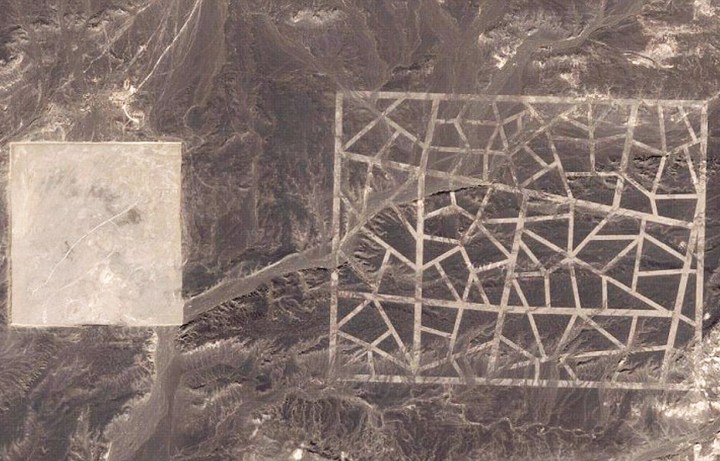Sci-Tech
Unidentified Frying Object: what the hell is in China’s desert?

Prepare for paranoia. Deep in China’s Kumtang Desert, a series of strange patterns have emerged. Easily viewed on Google Earth—a program that has made it difficult for me to sleep at night—the structures have caused a flurry of discussion on the interwebs. Mining complexes? Alien landing pads? It’s anyone’s guess. By RICHARD POPLAK.
One of them looks like the botched tattoo on a drunken fratboy, etched on his skin during a vacation in a sordid Mexican seaside town. Another looks like the biggest, brightest toy store ever built—that just happens to be in one of the more remote parts of the planet. Still another looks like concentric burn marks caused by a vast UFO, or worse, a huge blast of some description. All of them are visible on Google Earth; all of them are located in or near the Kumtang Desert, near the Chinese border with Tibet. No one is quite sure what to make of them.
The speculation seems particularly appropriate, given that the UFO Science and Consciousness Conference 2011 has just wrapped up in Johannesburg. The conference’s 13 speakers included “leaders in the fields of UFOlogy, genetics and micro-biology, alchemy, healing, bio-mimicry, ancient wisdom, numeric science and the formation of a money-less society”. Whether they touched on the shapes in the Chinese desert, you’ll have to ask deputy Maverick editor Phillip de Wet. He was there while I was otherwise preoccupied for the duration of the conference.
Nonetheless, some of the boffins at the conference are no doubt aware that one of the earliest UFO sightings occurred in China, by a Song government scholar-official named Shen Kuo. He recorded the testimony of those that witnessed a pearl-like object shine a prodigious light, and take off at vast speeds, and recorded all of this down in his Dream Pool Essays. That was in 1088. A millennium later, the UFOs seem to be back, causing all sorts of havoc in the Chinese desert.
Or maybe not. The big blue toy store looking thing? That is almost certainly a potash fertilizer plant, a structure the Chinese desperately need if they hope to keep feeding their billion-plus citizens. It’s located in Lop Nur, which just so happens to be a hopefully dormant Chinese nuclear testing site. Certainly, the plant—which is gargantuan by any standards—could be hiding something else, in a sort of giant blue bluff. If that’s the case, the nearby mine could either be uranium (pure speculation) or something as innocuous as coal (just as speculative.) In short, probably a potash plant. Maybe.
But what about those crazy patterns etched into the desert? They certainly look like the grid of a city, and are big enough to suggest that the Chinese have designed these for complicated war games. The burnt-out vehicles that are just visible would back this up. The grids have been transposed over cities like Washington, with the transposers insisting they are built to resemble major capitals, and thus imply imminent invasion. No one has plonked the grids over Johannesburg or Cape Town or Mangaung – yet. It certainly seems likely that the grids—their immense size notwithstanding—are theatres for war games. The Chinese have built similar scaled models before, in one case a 1:20 scale model of the border territory with India. The scaling down seems odd, considering that war is fought on a 1:1 ratio, but we’ll let that pass for now.
What all this really means, of course, is that we have no freaking clue what the Chinese are up to. Even their war games are inscrutable, played on a scale that boggles the mind – or reminds you of World War II war room with WAFs shuffle-boarding flags around a gigantic map. Scribbled into the Kumtang Desert are not the sinister shenanigans of some alien race, but the work of the world largest nation-state asserting technological and military power commensurate with its influence. Scroll Google Earth over the Moab Desert, and you’ll find similar structures. And the towns in the middle of nowhere that resemble Iraqi cities? Those are built to resemble Iraqi cities, so the American military can play at war games.
Deserts are strange places. Even from the relative safety of Google Earth, what happens in the desert stays in the desert. This surge of paranoia over the shapes in the Kumtang are really concerns about the intentions of the Chinese. But China’s intentions are plain. They need to grow, and in growing will become increasingly assertive. In their own deserts. And, maybe, one day in ours. DM
Read more:
- “Mystery of patterns in the Chinese desert solved…mostly,” in The Guardian;
- “Why is China building these massive structures in the desert,” in Gizmodo.






 Become an Insider
Become an Insider